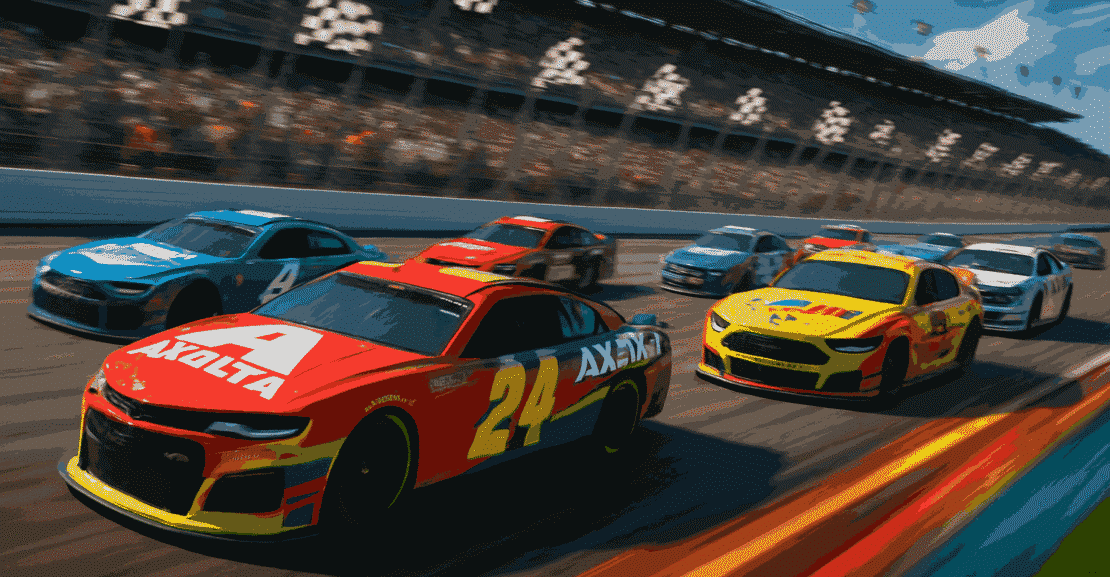If you’ve ever tuned into a NASCAR race and caught yourself thinking, “Wait… how many cars are actually racing out there?” — you’re definitely not the only one.
NASCAR — short for the National Association for Stock Car Auto Racing — is one of the biggest names in motorsports across the world. But when it comes to the number of cars in NASCAR events, things get interesting. Let’s take a closer look and see what really goes into that high-speed lineup on race day.
A Quick Look at NASCAR’s Roots — Where Speed Met Rebellion
To truly understand how many cars in NASCAR line up today, we first need to rewind a bit — all the way to the early 20th century.
Imagine the United States in the 1920s. Jazz ruled the night, flapper fashion turned heads, and underground bars called speakeasies served illegal booze during the Prohibition era. But ever wondered how that moonshine reached those hidden bars?
That’s where the story of NASCAR quietly began.
Back then, daring drivers — known as runners — secretly transported moonshine, dodging police at every turn. They didn’t just rely on luck. These runners modified their cars with faster engines and stronger suspensions, creating vehicles built for speed and survival on rugged backroads.
Over time, these drivers didn’t just race away from the law — they began racing each other. Local folks started organizing small events to watch these high-speed showdowns. It was raw, loud, and thrilling. No big sponsors, no massive crowds — just man, machine, and moonshine-fueled competition.
And that’s how the foundation of modern NASCAR was laid — from outlaws to organized racing legends.
How NASCAR Grew: From Moonshine Runs to a Racing Empire
As the 1930s ended and the 1940s began, America changed — Prohibition was over, but the legacy of those fast-paced moonshine deliveries stayed alive. The drivers who once raced to dodge police now had a new passion: racing for the thrill of it.
The backroads turned into dirt tracks. Small towns began organizing proper races. And by the mid-1940s, stock car racing wasn’t just a local event anymore — it was becoming a full-blown sport.
In 1948, a man named Bill France Sr., who was both a mechanic and a racer, saw the big picture. He believed this sport needed rules, structure, and one solid organization to take it forward. That’s when NASCAR was officially born.
In its early days, NASCAR races featured cars that looked like what you’d see at a dealership — just faster and tougher. The races happened on everything from sandy beach tracks to dusty dirt roads. But as the sport grew, so did everything around it.
New tracks were built with better surfaces — dirt was replaced by asphalt. The cars stopped being regular road models and turned into machines built purely for speed and endurance. Sponsors began showing interest. Technology entered the scene. Races got more complex — no longer just “who’s fastest,” but about pit stop timing, tire management, team strategy, and split-second decisions.
The number of cars in NASCAR races began to rise, and the competition grew fierce.
And then came TV.
Once NASCAR started being broadcast into homes, its popularity exploded. It wasn’t just a Southern U.S. sport anymore — it became a national obsession, and soon, a global one.
But even with all the glitz and evolution, one thing never changed: NASCAR still carries the soul of those fearless moonshine runners — full of fire, freedom, and the will to win.
Understanding the NASCAR Universe: It’s More Than Just One Race
When people ask, “how many cars in NASCAR?”, they’re often surprised to learn that the answer depends on which NASCAR series you’re watching. NASCAR isn’t just one big race — it’s a full racing world, divided into multiple series, each with its own style, rules, and audience.
NASCAR Cup Series – The Main Event
This is the top tier — the elite level of stock car racing. The Cup Series features the sport’s biggest names, fastest cars, and most-watched races. If a driver wins here, they’re considered one of the best. It’s the spotlight where champions are made and history is written.
Xfinity Series – The Proving Ground
Often called NASCAR’s “minor league,” the Xfinity Series is where future stars cut their teeth. But don’t be fooled — the competition here is intense. Young drivers compete against each other and occasionally face off against Cup Series veterans who drop in for select races. It’s fast, gritty, and filled with hungry talent.
Truck Series – Stock Car Racing with a Twist
Looking for something different? The NASCAR Craftsman Truck Series brings that extra flair. Instead of regular stock cars, this series features pickup trucks roaring down the track. It may sound odd, but these races pack serious speed and action, with their own fanbase and unique energy.
Each series has a different race format, different rules, and yes — a different number of cars on the track.
That’s what makes NASCAR so dynamic — it’s like a playlist of racing styles, with each series offering its own beat, thrill, and set of challenges.
How NASCAR Races Actually Work — It’s Not Just Who’s Fastest
When people think of NASCAR, they often imagine a loud, high-speed dash to the finish line. But behind that roar of engines lies a race format that’s carefully crafted for strategy, skill, and spectacle.
First Comes Qualifying
Before any driver takes part in the main event, they have to earn their spot. That’s where qualifying rounds come in. Drivers take turns pushing their cars to the limit — it’s not just about raw speed, but timing, focus, and nailing that one perfect lap.
Why does it matter? Because a strong lap time decides where you start on the grid. And in NASCAR, starting position can shape your entire race. The fastest qualify for the best spots. The rest? They either start further back or, in some cases, don’t make the cut at all.
Then Comes the Main Race
Once the qualifying dust settles, it’s time for the real deal: the main event. The grandstands are full, engines roar to life, and fans hold their breath as the cars roll onto the track.
But this isn’t just about going fast. Each race is a chess match at 200 mph. Drivers and teams think ahead — planning pit stops, tire changes, fuel strategies, and how to manage positions lap by lap. One small mistake can cost the race. One bold move can win it.
And depending on the series — Cup, Xfinity, or Truck — the number of laps, cars, and rules vary. But one thing stays the same: heart-pounding action from start to finish.
So… How Many Cars in NASCAR Races?
That’s the big question — and the answer isn’t just a guess. NASCAR sets a strict car count to keep races competitive and safe.
Back in the Day: When More Was More
In NASCAR’s earlier years, races could have up to 43 cars on the track — sometimes even more. It made for chaotic, high-action racing. But with more cars came more risks: crashes, mechanical failures, and tighter racing lines.
Over time, as the sport grew and safety standards evolved, organizers realized the need for consistency and control.
Today’s Standard: 40 Cars in the NASCAR Cup Series
Now, the NASCAR Cup Series — the top tier — runs with a set field of 40 cars per race. This number was finalized to keep things balanced: exciting, but safer.
It’s like having 40 top athletes in one arena, each battling for glory, speed, and legacy. Every car on that track has a story — a driver, a team, a strategy, and a burning desire to win.
A Race of Strategy, Skill, and Steel
So when someone asks, “how many cars in NASCAR races?” — the answer is usually 40, at least in the Cup Series. But it’s not just about numbers. Every race is a carefully designed blend of tactics, talent, and adrenaline.
That’s what makes NASCAR more than a race — it’s a full-throttle test of everything a driver has.
What Decides How Many Cars Are in a NASCAR Race? It’s More Than You Think
Sure, NASCAR is about speed, roaring engines, and edge-of-your-seat finishes. But when it comes to how many cars in NASCAR races actually hit the track — there’s a lot going on behind the scenes.
It’s not just, “Hey, let’s throw 40 cars out there and go!” It’s a careful mix of money, planning, competition, and team goals.
Sponsorship: The Fuel Behind the Field
All those flashy logos you see on NASCAR cars? They’re not just for show. They’re the reason many of those cars are even on the track.
Running a NASCAR team is wildly expensive — we’re talking millions per season. Teams spend money on car development, driver salaries, travel, gear, mechanics, and tech. Without sponsors, it simply wouldn’t be possible.
In return for those funds, brands get exposure to a massive fanbase. The better the team does, the more airtime those logos get — so it’s a win-win.
But here’s where it gets interesting:
➡️ Big sponsors = more money = more cars.
Some well-funded teams field two or even three cars in a race to increase their chances.
➡️ Smaller budgets = fewer cars — or none at all.
That’s how money shapes the field size, race by race.
Strategy: It’s Not Always About Quantity
Even if a team can afford to run multiple cars, should they?
Every NASCAR track is different. Some are all about top speed. Others demand technical precision and car control. A smart team knows when to go all in with multiple cars — and when to focus all effort on just one entry.
Example:
- A team has great history at a certain track? They might add a second or third car there.
- Struggling at a specific circuit? They might scale back and focus fully on one strong driver.
It’s also about reading the competition. If a rival is dominating the season, other teams may increase their presence to fight back — or avoid head-on clashes to protect points.
Even driver personalities matter. Two aggressive drivers on the same team can either push each other forward — or crash fighting for the same position. It’s a balancing act.
So, Why Do We Usually See 40 Cars in the Cup Series?
Because that’s the sweet spot NASCAR has settled on — competitive but controlled.
It gives room for big teams and smaller ones, ensures safety, and still delivers thrilling action.
But don’t forget:
Every one of those 40 cars has a story.
Each is backed by a team that’s made tough calls — about money, people, and long-term plans — just to make it onto that starting grid.
Final Thoughts: The Numbers May Stay the Same, But the Game Keeps Changing
Today, 40 cars is the norm in the Cup Series. But NASCAR has never stopped evolving. From wild moonshine runs to high-tech tracks, from 43+ cars to fine-tuned 40 — change is built into its DNA.
Who knows what’s next?
New rules, new formats, new limits — or no limits at all.
What we do know is this:
Every NASCAR race is a team effort, a business operation, and a passionate pursuit rolled into one. And the number of cars on the track? That’s just one part of a much bigger, more fascinating story.

